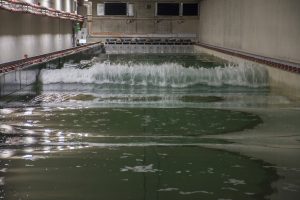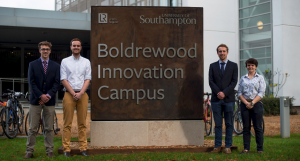Our next seminar is on Feb 11th 2016, 12:00-13:00 in B176/2013. All are welcome to attend.
Dr.Ioannis K. Chatjigeorgiou from National Technical University of Athens.
Hydrodynamic slamming is the phenomenon that is induced by the violent collision of a volume of liquid with a structure. It is violent because of the large velocities (either of the liquid or the structure) which are developed at the time of the impact. The duration is short but the loads exerted on the impacted structure are huge. Typical examples which are of great interest for marine applications are, the sudden entry of ship sections in an otherwise calm free-surface and the breaking wave (overturning, plunging-type waves) impact on structures. Violent hydrodynamic slamming has other important applications as well, such as sloshing of liquids in enclosed compartments.
Indeed the phenomenon under consideration is literarily unexplored and many aspects of it ill-understood. 3D solutions are scarce in the literature and when they exist, they concern simple geometries. Aside from the difficulties associated with the formulation of the breaking waves at the time of the impact (shape, velocity, existence of cavity, possible aeration), 3D slamming problems involve more challenges which arise from the fact that the actual impacted area is one of the problem’s unknowns.
The lecture will address some of the issues associated with the hydrodynamic slamming due to the wave impact on otherwise still structural components, focusing on the proper formulation of the problem and the employment of robust mathematical methodologies for the solution.
Biography
Dr.-Eng. Ioannis K. Chatjigeorgiou is Associate Professor in the School of Naval Architecture and Marine Engineering of the National Technical University of Athens. He is currently Professor (Marie Curie Research Fellow) in the School of Mathematics of the University of East Anglia, Norwich, UK. In the past he has been a visiting professor in Ecole Centrale Marseille, France and NTUN, Trondheim, Norway. He has more than 20 years experience in teaching and research, while he has participated in many research projects. Aside from hydrodynamic slamming, his has worked on issues related with linear and nonlinear hydrodynamics, hydroelasticity, wave resistance problems, interactions of structures with waves-current, environmental loading and response of floating structures, cable and slender structures dynamics, dynamics of pipes (risers) with axial flow, numerical methods in line dynamics, design and analysis of mooring systems, hydromechanics analysis of moored floating structures.
All posts by Stephen Turnock
Dolphins, Octopuses, Seagulls and Clams: The life of the SMMI Barrelman
Dr Simon Gerrard will start our 2nd Semester external seminar programme on Thursday 4th February at 12 noon in 176/2013. All are welcome.
Abstract
Like it or not it’s a fact of modern higher education (research and teaching) that links with business are becoming paramount. This is particularly true at the moment. Our reliance on capitalism as the organising principle for our society, coupled with the global economic downturn, puts increasing emphasis on the value of research and teaching outputs as a mechanism for enhancing economic growth.
Drawn from experiences over the past two decades and focusing more recently on the perspective of the Southampton Marine and Maritime Institute (SMMI), this talk explores in a practical way the links between academia and industry. For those unfamiliar with SMMI’s structure and function the talk will outline the Institute’s purpose and highlight its operating principles: think ‘dating agency’ are you’re not too far from the mark.
The talk explores the different ‘species’ that exist in the world between academia and industry, and offers a personal perspective on the future of research funding in a world dominated by the need for efficiency, austerity and economic growth based on knowledge. Taking great care not to provide too many direct answers, the talk poses the question ‘where might FSI be in 2025’ and wonders to what extent the future remains in our own hands.
Biography
Dr Simon Gerrard has over 10 years’ experience as an academic, albeit quite some time ago now, and nearly 20 years’ experience working in the area between academia and industry. He arrived at Southampton University in March 2014 as the Industry Liaison Manager in the Southampton Marine and Maritime Institute (SMMI). Two key roles of this post are to diversify the University’s research funding and enhance its global distinctiveness in marine and maritime activity. The principle method of achieving these aims is by stimulating greater levels of multi- and inter-disciplinary research between academics, researchers, business, government and other organisations.
Prior to this post (1988-1999) Simon was a member of faculty in the School of Environmental Sciences at the University of East Anglia, Norwich. His research focused on environmental risk management. Formerly an advisor to the World Health Organisation on Risk Communication, Simon established the European Risk Communication Network – a place where academics and practitioners could meet to discuss risk communication. Similarly, Simon ran the East Anglian Business Environment Club, another academic/industry network. In 1999 he became the School’s first Business Innovation Manager responsible for creating an outreach and commercialisation platform. In 2002 he established the Community Carbon Reduction (CRed) programme, the first of its kind in the UK. Through a few more steps, this led to the creation of a university spin-out carbon management consultancy which, amongst other things, operated a range of low carbon technology investment funds.
Tokyo 2015 Ship Hydrodynamics Workshop (2-4 December)
New Frontiers Fellow Dr Joe Banks and PhD student Artur Lidtke represented FSI at Tokyo 2015. The Ship Hydordynamics workshop, organised by and held at the facilities of National Maritime Research Institute (NMRI) of Japan, attracted a large number of attendees from academic and industrial backgrounds alike. Over 30 groups submitted results to allow for an assessment of the state of the art in hydrodynamic prediction methods related to ship flows. Investigated cases included the Korean Container Ship (KCS), ONR tumblehome ship (ONRT), as well as a completely new bulk carried hull, the Japanese Bulk Carrier (JBC).
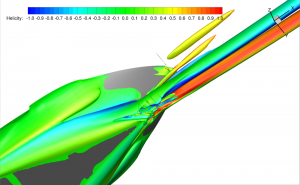
The latter proved to be particularly challenging to evaluate numerically due to its high block coefficient and the resultant complex vortex structure in the wake. Most of the participants were able to predict the global forces acting on the hull and propeller with reasonable accuracy, but only the most advanced highly-resolved LES and Reynolds Stress transport RANS models were found to be capable of capturing the nature of the hook-shaped vortex in the stern region.
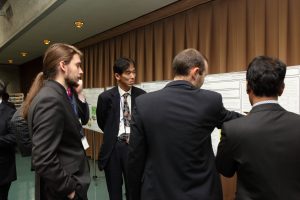
The submission by the FSI group focused on the towed and self-propelled JBC cases. The former were found to agree well with similar submissions from other institutions. FSI was the only participant to evaluate the same case using more than one code using nearly-identical numerical setup and the same grid. Doing so helped to distinguish between prediction errors due to fundamental shortcomings of the RANS method used and implementation- and user-induced inaccuracies.
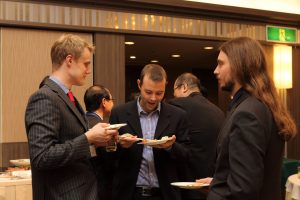
The Southampton maritime CFD team are the only UK based group to participate regularly in these workshops that originated from the International Towing Tank Conference in the 1980’s. They have presented their work in Gothenburg in 2000 and 2010 and previously in Tokyo in 2005. A number of those involved in those years attended as representatives from other organisations worldwide.
Making Waves in the Southampton Boldrewood Innovation Campus Towing Tank
Research has recently been undertaken utilising the new 138m towing tank at the University of Southampton. Funded by the Higher Education Innovation Fund (HEIF) via the Southampton Marine and Maritime Institute (SMMI), the research is a collaboration between Dr Sally Bennett (Fluid-Structure Interactions) and Prof. Robert Marsh (Ocean and Earth Sciences) which looks at the characterisation of freak wave groups for safer ship routing. The research strongly links with PhD research being undertaken by Alex Cattrell within the Fluid-Structure Interactions group at University of Southampton.
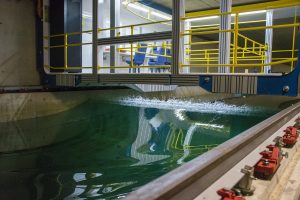
The recent testing focussed on the characterisation of freak waves and freak wave groups in terms of their formation and shape. Waves were generated at a scale of 1:22. A combination of photography, video imagery and state-of-the-art ultrasonic wave probe technology was used to analyse the wave formation including breaking wave characteristics where appropriate. A video of some of the testing can be found at https://youtu.be/EQ05QXMoShg.
Following this investigation into the wave groups themselves, this project will continue by looking at the influence of these waves on a ship, and how to manoeuvre the vessel through the waves to minimise structural loading, and therefore damage.
GDP 2 – Autonomous Hull cleaning Robot
Last but not least of our series introducing this years Group Design Projects run from the ship science programme. The project aims to solve many problems that hull fouling causes, both environmentally and financially. To name a few:
- 39% of invasive species transported by shipping are found in the hull fouling (Molnar et al., 2008)
- A fouled hull leads to increased fuel consumption and carbon emissions (M.P. Schultz, 2010)
- Existing cleaning methods require the ship to remain in port
We are undertaking the design build and test of an autonomous hull cleaning robot, capable of regularly cleaning the hull of a ship while the ship is at operational speeds.
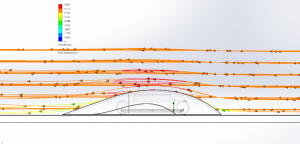
To achieve this we are going to:
- Develop an attachment method capable of resisting the forces the robot is subject to at operational ship speeds.
- Develop the autonomous system which is able to navigate a defined area, maintaining knowledge of its position within the domain and avoiding obstacles.
- Design and test a body form which is optimised to aid the attachment method
- Manufacture the various elements of the robot to be tested individually
- Test the ability of the final assembly to perform under simulated operating conditions
Unsteady fluid Interaction effects on riser clusters -FSI Seminar 10th Dec
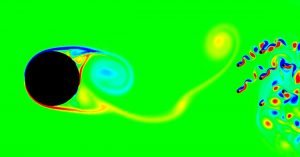 FSI Seminar on Thursday 10th December in 176/L1107,
FSI Seminar on Thursday 10th December in 176/L1107,
Boldrewood Innovation Campus
to be given by Christian Klettner, Research associate, Mechanical Engineering, University College London
Risers from the sea floor to installations at the sea surface are an integral part of the flow assurance of deep sea oil exploration, which has become necessary in the last decade. These risers are subjected to various hydrodynamic forcing, particularly sea currents, wakes of upstream installation members and surface waves, which can result in vortex or wake induced vibrations and these in turn can result in riser fatigue or collision. The free stream flow past groups of cylinders has been studied for two- and three-dimensions for Re=100(based on the cylinder diameter) by Nicolle & Eames (2011) (direct numerical simulations) and ReO(10000) by Chang \& Constantinescu (2015) (large eddy simulations) respectively. In this study we will be focusing on the first two aspects listed above, numerical simulations will be performed to investigate the effect of an upstream truss on an array of cylinders. The main diagnostic will be how varying the void fraction of the array of cylinders affects the frequency and magnitude of the drag and lift forces on the cylinders.
Brief CV
Christian Klettner received his BEng in 2006 and PhD in 2010 from University College London. His PhD, under the supervision of Ian Eames, was on aspects of solitary waves propagating over different topography using numerical simulations. He was in at National University Hospital Singapore as a post doc for 2.5 years developing numerical models and performing small scale experiments on transport in hospital rooms. He is now a post doc at UCL Department of Mechanical Engineering working on the project URBANWAVES which is in collaboration with UCL Civil Engineering Department. The project will investigate the forces exerted on coastal installations during tsunami and storm surge inundation which will require the development of various numerical methods. The intention is to calibrate a shallow water model with large scale numerical simulations of the flow past a building with varying blockage ratio. These can then be incorporated into city wide shallow water models.
Ships Science students visit Arcadia and Queen Victoria
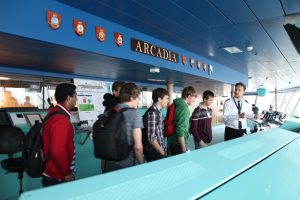
Part 1 ship science students were given special tours around the P & O Cruise ship MV Arcadia and Carnival Cruise ship MV Queen Victoria, when they were docked simultaneously recently in Southampton port.
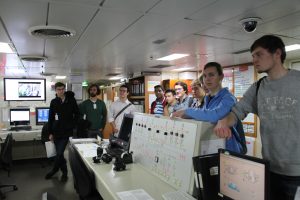
During the turnaround on that day of both ships the ships’ crew gave the group of ten students in each case a wide ranging tour of the ship. This included in particular the engine control room, main engine room, podded propulsion area and the bridge, which helped the groups understand how really big ships work.
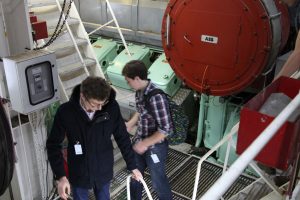
As the group moved around the ship public spaces were examined as were the access between different decks. The scale of ship was brought home by the constant movement of stores along the main access area for stores, luggage and crew. The ship’s crew were extremely helpful in answering a whole plethora of technical questions. Prof Philip Wilson accompanied the group on the Arcadia and Dr Jon Downes accompanied the group on the Queen Victoria.
Next week a group of 20 Part 1 ship science students will tour around the MV Ventura when she is in Southampton port.
https://en.wikipedia.org/wiki/MV_Arcadia_(2004)
https://en.wikipedia.org/wiki/MS_Queen_Victoria
Delphin2 Trials continue at Eastleigh Lakes
Delphin 2 has been the subject of a series of experiments in the Boldrewood Towing Tank but last week the emphasis was to have spiral manoeuvring trails in the Eastleigh lakes. So Kantapon and Sophia the two doctoral students who are using Delphin 2 for their research together with Prof Wilson transported Delphin 2 to the Eastleigh lakes.
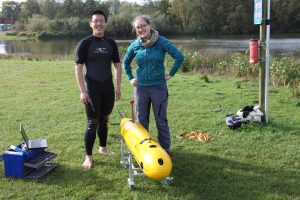
At this time of the year the weather plays an important role, but in the morning we had nearly flat calm conditions as well as sun, so we were able to set up and get the tests started promptly.
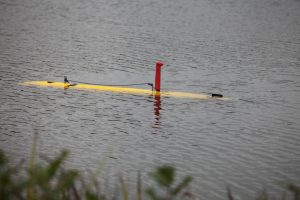
Light stopped play at 3pm. The tests were a success and we certainly achieved a great deal of outreach since there were a constant flow of people asking what were we doing.
Work on Delphin2 has been ongoing over a number of years and is part of the activities of the maritime robotics laboratory and is in collaboration with Drs Phillips and Furlong at the National Oceanography Centre, Southampton.
GDP81 Wingsail for Southampton Hydro-Aero Research Catamaran
We are working on a project to fit a wing sail and set of hydrofoils to an F18 catamaran, called SHARC (Southampton Hydro-Aero Research Catamaran). The aim would be to create a wing sail and foil system that can then be rescaled to attach other types of dinghy and be easily broken down for easy travelling.
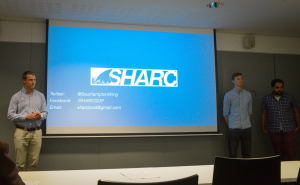
The project is the culmination of our four year degree in Naval Architecture/Maritime Engineering and will result in the finished boat being sailed in April. We hope that the project will provide a platform for testing new hydrofoil and wing sail systems that will be developed over the coming years by the university.
The wing sail which is being built for the project will be similarly shaped to those already being used by Americas Cup teams and the C-Class catamarans. We are going to have a leading and trailing flap, which will have a controllable camber, and then a top section that can be twisted off in heavier winds. The major problem with a wing sail is making the rig light enough to be able to not adversely affect the performance of the boat, and so lightweight and strong rigging will be crucial to the success of the project. We are fortunate to have the support of Forward WIP who will ensure that the sailors are properly fitted out so that they are as safe as possible during testing, their range can be found here: http://www.forward-wip.com/
We hope to begin building in January, and will be sailing the wing in March next year. Find us on Facebook to stay up to date with all of the developments! Facebook: /SHARCGDP
GDP63 Team Fortitude – Autonomous Operations at Sea
Team Fortitude has now become a group of nine finalists (six ship scientists and three mechanical engineers) who aim to show proof of concept for a number of autonomous solutions applicable to full scale ships using last year’s autonomous surface vessel (ASV), Fortitude.

In 2013, 54 ships were lost at sea, sank or were never found and it’s recognised that around 80% of marine accidents involve some aspect of human error. The Team wants to explore how the number of casualties at sea could be reduced by enhancing automation to aid human part of operation from ships. Beyond the safety concerns, up to 40% of a ship’s operating costs are associated with crewing. The hours can be long and with significant time spent away from home. If you can alter the responsibilities and hours and potentially base more of the crew in shore based roles you can improve working conditions and reduce some of this cost. Team Fortitude wants to prove the feasibility of autonomous ships by showing how a number of autonomous solutions can approach day to day operational requirements on a vessel (e.g. navigational decision making, diagnostics communications, tank operations and fluid movements etc.). These solutions will be scaled down and applied to the current Fortitude platform to investigate these issues.
By the end of the academic year the Team hope to test the ASV with a fully autonomous journey around the Isle of Wight. Under current constraints this is a totally feasible objective and will not pose any threat to Fortitude as the trip can be supervised. Under additional support the Team will be able to further their improvements to set Fortitude up for a transatlantic crossing. The journey has never been done by an ASV and it would be a fantastic opportunity for the University to make the very most of. The trip would take around 40 days and would truly push the longevity of autonomous parts, a fact that would be absolutely vital for a fully autonomous ship.
To stay up to date with Team Fortitude, head to www.facebook.com/fortitudeASV and/or www.twitter.com/fortitudeASV or to get in touch email fdt@soton.ac.uk.

